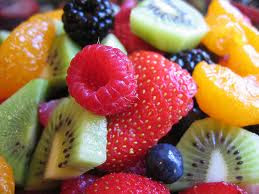Choosing your fruit for juice wisely. Basically all fruits and vegetables can be used to make juice, as long as it does not contain fat (fruit advocado) or substances that can cause irritation and allergies (pineapple, strawberries and other berries, but if not allergic can still be consumed). Materials used are raw, not cooked. Use organic and natural ingredients are not contaminated by the toxic substance or pesticide. Especially for people who are sick, try not to give food contaminated by pesticides and harmful chemicals. For example, cancer patients tend to be more sensitive to pesticides than healthy people or other diseased.
The definition of natural is a plant that is planted in the ground, not hidroponic, airophonic, without soil or other growing techniques. The resulting plants do not contain nutrients and minerals complete than that planted in the ground. In circumstances in which organic materials difficult to obtain, non-organic materials can still be used to thoroughly wash this material well and is always immersed for 5 minutes in advance with the water that has been poured with hydrogen peroxide (H2O2) (2 liters of water mixed with a teaspoon of 3% H2O2, can be purchased at pharmacies and cheap). This is the point that pesticides in food that dissolves skin and cleaned.
 If you do a juice therapy, use of native trees, where you can go directly to producers / farmers and ensure that their products are completely organic. Do not stick to the type of fruit imports. Local fruit as well, even relatively fresh. You can make use of watermelon, cantaloupe, guava, guava kelutuk, starfruit, mango, Dutch eggplant, sweet orange, grapefruit, lime, soursop, suri cucumber, cucumbers, and other fruits are always available in the market. continue reading here for other article.
If you do a juice therapy, use of native trees, where you can go directly to producers / farmers and ensure that their products are completely organic. Do not stick to the type of fruit imports. Local fruit as well, even relatively fresh. You can make use of watermelon, cantaloupe, guava, guava kelutuk, starfruit, mango, Dutch eggplant, sweet orange, grapefruit, lime, soursop, suri cucumber, cucumbers, and other fruits are always available in the market. continue reading here for other article.
Banana and papaya can be eaten just like that, but in-juice is also quite tasty. For orange, it is easier just milked the masticator orange plates. Similarly, the vegetables, you can use carrots, green cabbage, red cabbage, various types of lettuce, mustard greens, spinach, pok choi, beans, bean sprouts, and other vegetables that taste quite okay to eat (vegetables usually slightly unpleasant taste and smell , so sometimes mixed with fruit that tastes better)
The definition of natural is a plant that is planted in the ground, not hidroponic, airophonic, without soil or other growing techniques. The resulting plants do not contain nutrients and minerals complete than that planted in the ground. In circumstances in which organic materials difficult to obtain, non-organic materials can still be used to thoroughly wash this material well and is always immersed for 5 minutes in advance with the water that has been poured with hydrogen peroxide (H2O2) (2 liters of water mixed with a teaspoon of 3% H2O2, can be purchased at pharmacies and cheap). This is the point that pesticides in food that dissolves skin and cleaned.
 If you do a juice therapy, use of native trees, where you can go directly to producers / farmers and ensure that their products are completely organic. Do not stick to the type of fruit imports. Local fruit as well, even relatively fresh. You can make use of watermelon, cantaloupe, guava, guava kelutuk, starfruit, mango, Dutch eggplant, sweet orange, grapefruit, lime, soursop, suri cucumber, cucumbers, and other fruits are always available in the market. continue reading here for other article.
If you do a juice therapy, use of native trees, where you can go directly to producers / farmers and ensure that their products are completely organic. Do not stick to the type of fruit imports. Local fruit as well, even relatively fresh. You can make use of watermelon, cantaloupe, guava, guava kelutuk, starfruit, mango, Dutch eggplant, sweet orange, grapefruit, lime, soursop, suri cucumber, cucumbers, and other fruits are always available in the market. continue reading here for other article.Banana and papaya can be eaten just like that, but in-juice is also quite tasty. For orange, it is easier just milked the masticator orange plates. Similarly, the vegetables, you can use carrots, green cabbage, red cabbage, various types of lettuce, mustard greens, spinach, pok choi, beans, bean sprouts, and other vegetables that taste quite okay to eat (vegetables usually slightly unpleasant taste and smell , so sometimes mixed with fruit that tastes better)











0 comments:
Post a Comment